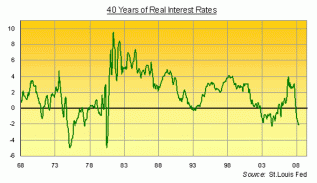What would you do if someone said that you could have a billion dollars, as long as you returned it after a year?
Media talks about a few things when examining causes of the credit crisis
1. Under regulation
2. Greedy, over leveraged wall street investments.
3. Defacto government backing of risky mortgages.
While doing some research of my own, I uncovered another factor that could have accelerated all three elements. It has to do with the fact that from 2003 to 2006, big players could borrow money for virtually nothing.
This is a graph of Real Interest Rates for the last 40 years.
Explanation: (Real Interest Rate = Interest - Inflation)
Which means that if you lend your friend $1.00, he may agree to pay you $1.05 in a year. If the value of the dollar falls 5% due to inflation, then that $1.05 will buy less stuff now than your $1.00 could have bought one year ago. Essentially, you paid him a quarter of a cent to borrow your dollar for a year. That is what real interest rate measures.
Now look at the graph. For about a three year period starting before 2003, real interest is below zero. This was essentially a period of free money. Institutions could borrow as much money as they wanted. How is this possible?

Here is a graph of rates set by the federal reserve. During the same period in the early 2000's. The fed dropped rates dramatically, letting real interest slide below zero and facilitating massive borrowing.
Where was all of this money going?
Real Estate.
When the Fed dropped interest rates, money became free, that money went into real estate, and home prices increased.
When the fed came to it's senses and raised rates, real interest moved above zero, firms could no longer borrow irresponsible sums of money, investors stopped throwing funds at real estate, and home prices started to plummet; causing a global panic, and a stock market spiral; while taking down commercial banks, AIG, Fannie and Freddie, and all six American investment institutions.
And that is the cost of free money.

Some say that the bubble had been in the works for much longer than that. Here you can see where Nixon decoupled the US currency from a gold backing. Without this backing, the government was able to print more money than it could pay back. This excess printing increases the quantity of money and therefore decreases its value. This trend is reflected in the consumer price index starting in the 1970s.


 RSS Feed
RSS Feed